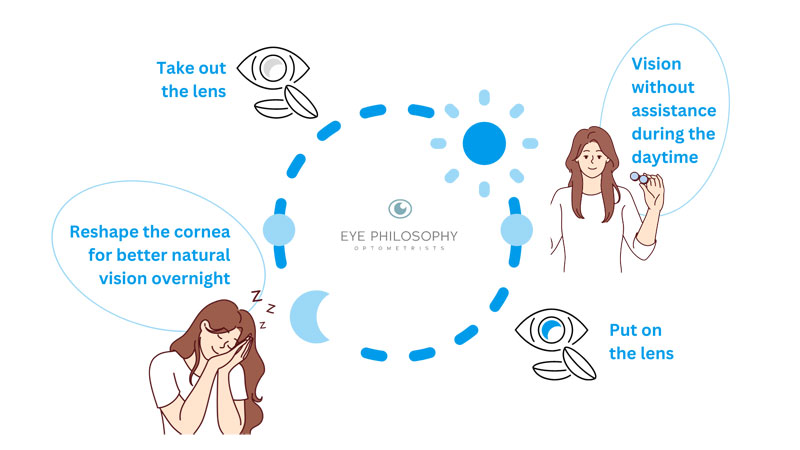Wake up to clear vision every single day. No more contacts, no more glasses.

Don’t wait, take the first step towards clear vision now! Our Ortho-K lenses starts at $499 through payment plans.
- Freedom from Glasses: Say goodbye to the hassle of glasses, soft contact lenses, and surgery. Ortho K, also known as Orthokeratology, is a revolutionary way to reverse short-sightedness naturally. These fitted lenses correct your vision while you sleep, allowing you to wake up free from glasses throughout the day!
- Safe & Effective for All Ages: Ortho-k lenses are typically made of a rigid gas-permeable material, allowing oxygen to reach the cornea during overnight wear. These lenses are safe for people of all ages, including young children.
- Slow Myopia Progression: Transform your child’s future with Myopia Control. Orthokeratology reduces myopic progression by reshaping the cornea to correct refractive errors, including myopia, so that you can see clearly during the day without the need for glasses or contact lenses. Ortho K is often recommended for children with progressing myopia.
- Non-Surgical & Reversible: Ortho K lenses offer a reversible and non-surgical alternative to gently improve your vision and slow myopia progression. It involves the use of specially designed contact lenses that are worn overnight to temporarily reshape the cornea, the front surface of the eye. The non-permanent nature of the correction is an advantage for those who may wish to discontinue for any reason.
- Advanced Technology & Safety: Orthokeratology technology has been around for several decades and has gained approval from health authorities worldwide. In 1994, the U.S. Food and Drug Administration (FDA) granted initial approval for Ortho K lenses and overnight wear was granted in 2002, allowing individuals to wear the lenses while sleeping for corneal reshaping. Individuals interested in Ortho K can trust in the established safety profile of the technology when prescribed and monitored by qualified eye care professionals.
Want to chat with a specialist? to Talk to our Ortho K Optometrist Today
Experience the freedom of clear vision with Ortho K!

How do I get started?
1. Book an Assessment:
2. Measurement and Appointment:
Using our advanced corneal topographer, precisely measure the shape of your cornea to ensure pinpoint accuracy in designing your custom lenses through our measurement and assessment process.
3. Design and Production:
4. Ortho-K Appointment:
5. Go to sleep:
6. Wake up with Clear Vision:
The idea of corneal reshaping to correct myopia may have originated more than 200 years ago when the Samurai’s used bags of sand resting on their closed eyelids to improve their vision prior to going to war.
Reshaping the cornea using standard rigid contact lenses was first reported in 1962 at the International Society of Contact Lens Specialists conference in Chicago, by George Jessen who described his “orthofocus” procedure. Unfortunately, this process took too long, and results were unpredictable. With technological advancements in lens materials and manufacturing, the modern reverse geometry Orthokeratology lens was introduced in the late 1980’s.11 In 1994, the United States FDA granted the first ever daily wear approval for Ortho-K and in June 2002, the FDA granted approval for overnight wear Ortho-K.
There is no specific age restriction for Orthokeratology. Children as young as five have successfully and safely received Ortho-K corneal reshaping. These lenses are scientifically proven to reduce or halt the progression of myopia, a process called myopia control and is one of the most popular methods of myopia control vision correction in children and teenagers.Any contact lens has the potential to cause an infection in your eyes. Research shows the rate of infection using Ortho-K lenses is less than half compared to overnight wear of extended wear soft contact lenses.
Using correct hygiene and lens care regimes as well as replacing the lenses every one to two years significantly reduces the risk of related complications.
A poorly fitted lens can result in corneal staining, which comprises the outer layer on the cornea, and increases the risk for infection. Rather than fit Ortho-K lenses through trial and error using a diagnostic lens from a trial case, EyeSpace software calculates and optimises the fit of each lens to the topographical shape of the cornea.
Book using one of the buttons below and see a bulk billing optometrist in our Williamstown or Doncaster office today!
